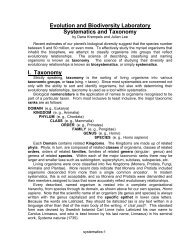The effect of over- feeding on the caterpillar species Vanessa cardui
The effect of over- feeding on the caterpillar species Vanessa cardui
The effect of over- feeding on the caterpillar species Vanessa cardui
You also want an ePaper? Increase the reach of your titles
YUMPU automatically turns print PDFs into web optimized ePapers that Google loves.
<str<strong>on</strong>g>The</str<strong>on</strong>g> <str<strong>on</strong>g>effect</str<strong>on</strong>g> <str<strong>on</strong>g>of</str<strong>on</strong>g> <str<strong>on</strong>g>over</str<strong>on</strong>g><str<strong>on</strong>g>feeding</str<strong>on</strong>g><strong>on</strong> <strong>the</strong><strong>caterpillar</strong> <strong>species</strong><strong>Vanessa</strong> <strong>cardui</strong>By: Santiago L<strong>on</strong>doñoSantiago L<strong>on</strong>doño, Christopher C<strong>on</strong>treras, Alexander Rodríguez, Justin Carasa, Andrea Remiro, Nicole Cinquino, and Michelle Ortiz. 6/21/12 HHMI Research in Ecology 2012 Introducti<strong>on</strong> <str<strong>on</strong>g>The</str<strong>on</strong>g> butterfly we tested <strong>on</strong> was <strong>the</strong> painted lady also called <strong>Vanessa</strong> <strong>cardui</strong>. <str<strong>on</strong>g>The</str<strong>on</strong>g> questi<strong>on</strong>we tested was how does <str<strong>on</strong>g>over</str<strong>on</strong>g>-<str<strong>on</strong>g>feeding</str<strong>on</strong>g> affect a <strong>caterpillar</strong>s growth. Our hypo<strong>the</strong>sis was that if you<str<strong>on</strong>g>over</str<strong>on</strong>g>-feed <strong>caterpillar</strong>s, <strong>the</strong> <strong>caterpillar</strong>s will grow faster than if you feed <strong>the</strong>m <strong>the</strong> normal amount<str<strong>on</strong>g>of</str<strong>on</strong>g> food. <str<strong>on</strong>g>The</str<strong>on</strong>g> reas<strong>on</strong> we tested this was in order to observe <strong>the</strong> difference between <strong>caterpillar</strong>seating <strong>the</strong> normal amount <str<strong>on</strong>g>of</str<strong>on</strong>g> food to <strong>caterpillar</strong>s eating more than <strong>the</strong> normal amount. Ano<strong>the</strong>rreas<strong>on</strong> why we tested this was because we knew that most animals will grow larger than normalif you feed <strong>the</strong>m large quantities <str<strong>on</strong>g>of</str<strong>on</strong>g> food.<str<strong>on</strong>g>The</str<strong>on</strong>g> reas<strong>on</strong> we choose this type <str<strong>on</strong>g>of</str<strong>on</strong>g> butterfly was because <strong>the</strong> painted lady has a quick lifecycle. Something I found out during this experiment was that <strong>the</strong> painted lady flies around 1000miles in its lifetime. <str<strong>on</strong>g>The</str<strong>on</strong>g> <strong>Vanessa</strong> <strong>cardui</strong> has a wingspan <str<strong>on</strong>g>of</str<strong>on</strong>g> 2 inches and has black skin withspikes.Materials & Methods <str<strong>on</strong>g>The</str<strong>on</strong>g> materials we used are <strong>the</strong> following: a butterfly kit c<strong>on</strong>taining <strong>caterpillar</strong>s, food, andc<strong>on</strong>tainers, 2 wax pencils, 1 pair <str<strong>on</strong>g>of</str<strong>on</strong>g> scissors, 1 roll <str<strong>on</strong>g>of</str<strong>on</strong>g> tape, 2 bins, 1 small bolt <str<strong>on</strong>g>of</str<strong>on</strong>g> cheese cloth, 2light sources, 1 timer, 1 surge protector outlet. <str<strong>on</strong>g>The</str<strong>on</strong>g> first thing we did is count 22 c<strong>on</strong>tainers andlids so that we could later put <strong>the</strong> <strong>caterpillar</strong>s in. Next we measure <strong>the</strong> food for both groups. Weput 9.1 grams <str<strong>on</strong>g>of</str<strong>on</strong>g> food in each c<strong>on</strong>tainer <str<strong>on</strong>g>of</str<strong>on</strong>g> <strong>the</strong> c<strong>on</strong>trol group and 13.6 grams <str<strong>on</strong>g>of</str<strong>on</strong>g> food in each <str<strong>on</strong>g>of</str<strong>on</strong>g>c<strong>on</strong>tainer <str<strong>on</strong>g>of</str<strong>on</strong>g> <strong>the</strong> treatment group (11 c<strong>on</strong>tainers in each group). <str<strong>on</strong>g>The</str<strong>on</strong>g>n we put 1 <strong>caterpillar</strong> in eachc<strong>on</strong>tainer. Next we put <strong>the</strong>m in <strong>the</strong> bins separating <strong>the</strong> c<strong>on</strong>trol from <strong>the</strong> treatment and labelingeach bin according. <str<strong>on</strong>g>The</str<strong>on</strong>g>n we check <strong>the</strong> temperature and <strong>the</strong> size and color <str<strong>on</strong>g>of</str<strong>on</strong>g> <strong>the</strong> <strong>caterpillar</strong>s tosee if anything changed.ResultsDuring this experiment <strong>the</strong>re were some strange things I noticed. One <str<strong>on</strong>g>of</str<strong>on</strong>g> <strong>the</strong> things Inoticed was that four <strong>caterpillar</strong>s died in this whole experiment and all <str<strong>on</strong>g>of</str<strong>on</strong>g> <strong>the</strong>m died frommysterious circumstances because when we looked at <strong>the</strong>m we couldn’t see <strong>the</strong>m at all as if <strong>the</strong>rewas no <strong>caterpillar</strong> inside. For <strong>the</strong> statistical values <str<strong>on</strong>g>of</str<strong>on</strong>g> <strong>the</strong> c<strong>on</strong>trol group I got a mean <str<strong>on</strong>g>of</str<strong>on</strong>g> 18.2 and avariance <str<strong>on</strong>g>of</str<strong>on</strong>g> 0.177778. For <strong>the</strong> treatment I got a mean <str<strong>on</strong>g>of</str<strong>on</strong>g> 18.875 and I variance <str<strong>on</strong>g>of</str<strong>on</strong>g> 0.982143. For<strong>the</strong> t test that I performed I got a P value <str<strong>on</strong>g>of</str<strong>on</strong>g> 0.105207 which means that I accept <strong>the</strong> null andreject <strong>the</strong> alternative.
C<strong>on</strong>trol Group Start Date Pupati<strong>on</strong> Date Total Days Treatment Group Start Date Pupati<strong>on</strong> Date Total Days C1 6/21/12 7/9/12 18 T1 6/21/12 7/9/12 18 C2 Dead T2 6/21/12 7/10/12 19 C3 6/21/12 7/9/12 18 T3 6/21/12 7/10/12 19 C4 6/21/12 7/9/12 18 T4 Dead C5 6/21/12 7/9/12 18 T5 6/21/12 7/12/12 21 C6 6/21/12 7/9/12 18 T6 Dead C7 6/21/12 7/10/12 19 T7 Dead C8 6/21/12 7/9/12 18 T8 6/21/12 7/10/12 19 C9 6/21/12 7/9/12 18 T9 6/21/12 7/9/12 18 C10 6/21/12 7/10/12 19 T10 6/21/12 7/10/12 19 C11 6/21/12 7/9/12 18 T11 6/21/12 7/9/12 18 Time Temp. Observati<strong>on</strong>s- C<strong>on</strong>trol Observati<strong>on</strong>s- Treatment Date 6/21/12 9:45 am 23°C No change No change 6/22/12 8:09 am 21°C No change No change 6/25/12 8:09 am 21°C <str<strong>on</strong>g>The</str<strong>on</strong>g>y have grown <str<strong>on</strong>g>The</str<strong>on</strong>g>y have grown 6/26/12 8:29 am 21°C <str<strong>on</strong>g>The</str<strong>on</strong>g>y look bigger, C-‐7 is <str<strong>on</strong>g>The</str<strong>on</strong>g>y look bigger smaller than <strong>the</strong> rest 6/27/12 8:16 am 21°C C-‐7 is dead No change 6/28/12 8:14 am 21°C All are big, forming web All are big except T-‐4, forming web 6/29/12 8:21 am 21°C No change No change 7/2/12 8:21 am 21°C No change No change 7/3/12 8:09 am 21°C Have white stripes Have white stripes 7/5/12 8:18 am 21°C Bigger Bigger 7/6/12 8:13 am 21°C All are <strong>on</strong> <strong>the</strong> top All are <strong>on</strong> <strong>the</strong> top except T-‐4, T-‐6, T-‐7 7/9/12 8:21 am, 21°C Chrysalis-‐C-‐1, C-‐3, C-‐4, Chrysalis-‐ T-‐9, T-‐1, T-‐11 C-‐5, C-‐6, C-‐8, C-‐9, C-‐11 7/10/12 8:17 am 21°C Chrysalis-‐C-‐10, C-‐2 Chrysalis-‐ T-‐10, T-‐8, T-‐3, T-‐2 7/11/12 8:26 am 21°C No change No change 7/12/12 8:13 am 21°C One Chrysalis is starting to open No change
Discussi<strong>on</strong>In <strong>the</strong> experiment we noticed that more <strong>caterpillar</strong>s died in <strong>the</strong> treatment group than in <strong>the</strong>c<strong>on</strong>trol group. One reas<strong>on</strong> why this might have happen was that since we put more food than <strong>the</strong>regular amount <strong>the</strong> <strong>caterpillar</strong>s moving space was less than what it should have been. By doingthis <strong>the</strong> <strong>caterpillar</strong> might not have had enough space to turn into a chrysalis. According to <strong>the</strong>statistics <strong>the</strong>re was no significant difference but <strong>the</strong>re was still a difference. <str<strong>on</strong>g>The</str<strong>on</strong>g> reas<strong>on</strong> why <strong>the</strong>rewas not a significant difference was that maybe we used a sample size to small or maybe toomany <str<strong>on</strong>g>of</str<strong>on</strong>g> <strong>the</strong>m died.C<strong>on</strong>clusi<strong>on</strong>Some <str<strong>on</strong>g>of</str<strong>on</strong>g> <strong>the</strong> questi<strong>on</strong>s that still remained after we finished <strong>the</strong> experiment were why did some<strong>caterpillar</strong>s not grow at all and <strong>the</strong> o<strong>the</strong>rs did and why did some <str<strong>on</strong>g>of</str<strong>on</strong>g> <strong>the</strong>m stop growing in <strong>the</strong>middle <str<strong>on</strong>g>of</str<strong>on</strong>g> <strong>the</strong>ir growth.
















